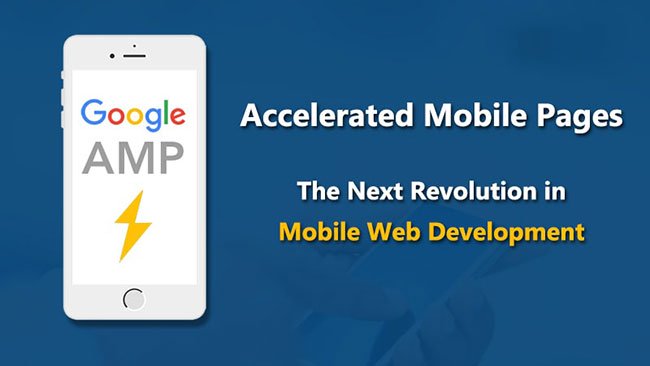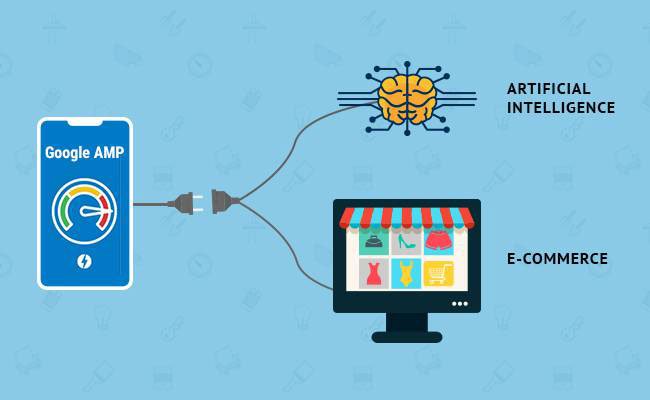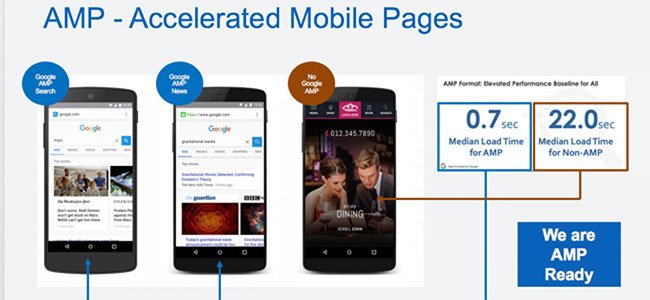What is AMP (Accelerated Mobile Pages)?
What is AMP? How does AMP work?
- What is AMP (Accelerated Mobile Pages)?
- How does AMP work?
- So should you use AMP for your website?
- What are the disadvantages of AMP?
- Is it possible to take advantage of the web-to-app experience on AMP websites?
What is AMP (Accelerated Mobile Pages)?

If you've ever searched for content and interacted with the results on a mobile device, you might have encountered AMP or Accelerated Mobile Pages.
AMP is an open source framework developed by Google in collaboration with Twitter. Accelerated Mobile Pages creates a better, faster experience on mobile web. At its core, this framework allows you to build lightweight experiences for mobile devices, by simplifying HTML and following streamlined CSS rules.
AMP was initially considered developed in response to Facebook's Instant Articles. However, over the years, it has become a powerful platform for distributing content directly from search results at the speed of light. Earlier this year, Google outlined a plan that announced that it would push AMP technology framework into web standards.
How does AMP work?

The AMP framework has 3 main parts.
- AMP HTML : Think of AMP HTML as a more compact version of regular HTML. The AMP framework has strict rules for HTML tags that you can use. To ensure fast page loading, certain HTML elements like forms are not allowed to appear on AMP. The AMP framework also requires that you use a streamlined version of CSS. See the full list of HTML tags needed for the AMP framework here:
https://amp.dev/documentation/guides-and-tutorials/start/create/basic_markup/?referrer=ampproject.org None of these tags is new, if you are familiar with building web content using modern HTML and CSS.
- AMP JS : To ensure fast page loading on mobile platforms, AMP restricts the use of any Javascript. The only exception is for AMP scripts, optimized for the purpose of increasing page load speed. AMP provides a library of easy-to-apply components. You can create animations, load dynamic content, modify layouts, and more with AMP's extensive component library.
- AMP CDN : Often referred to as the AMP Cache, an important component of the AMP platform is CDN (Content Delivery Network) based on proxy. CDN fetches AMP content and stores it for quick distribution. By default, the AMP CDN stores all valid AMP content and does not provide an opt-out option. However, you can continue to leverage your own CDN provider on the AMP cache to customize the content delivery configuration.
So should you use AMP for your website?

In the years since AMP was launched, it is generally accepted that media websites work well on AMP. Because much of the content on media sites is static, these sites have seen a significant increase in traffic from Organic Search Traffic (organic search results). In addition, Google has made it easier for publishers to make their content stand out with Rich Cards.
For e-commerce websites that have very dynamic content and vary based on user choices (filtering, sorting, adding to shopping carts and more dynamic user actions), level of AMP can increase performance on mobile devices to be launched. All SEO and mobile performance enthusiasts seem to agree that a well implemented AMP site will:
- Significant increase in volume of Organic Search Traffic.
- Increase engagement and conversion due to faster, better mobile experience.
- Reduce the load on the server because AMP CDN stores and responds to most search results.
- Give your content a chance to appear prominently in the mobile search results.
What are the disadvantages of AMP?

The most common reason some digital web brands have decided not to implement AMP is the level of effort needed to AMP web assets. It's undeniable that the potential for mobile is huge, but it also requires a holistic approach. To take advantage of the AMP experience, your development team will need to build and maintain AMP-specific assets.
Because AMP stores content without requiring a server each time, the analytics and measurement tools cannot be 100% dependent on server requests. You will need to implement special tracking parameters to accurately capture the CTRs and interaction metrics from the AMP version of the site.
Put simply, AMP is miniature HTML, which means you can't deliver rich experiences to users, such as moving maps, rotating images, etc. on AMP. If parts of the site rely heavily on UX, you might want to reconsider building AMP versions for those sections.
Finally, the AMP experience is enclosed and limited by design. Users can hardly do anything from the AMP experience, except back to Google search results. This creates the risk of losing mobile user engagement and potential conversion to your brand.
Is it possible to take advantage of the web-to-app experience on AMP websites?

The answer is yes! AMP provides a unique mobile opportunity for Organic Traffic, to search and discover content on the site. With Journeys web-to-app smart banners of Branch (link: https://branch.io/journeys/ ), you can continue exploring content, web connections and mobile apps, by building a custom web-to-app experience. Here are some specific experiences you can build with Branch on the AMP website.
- With Branch AMP's web-to-app Journeys, you can seamlessly route mobile users from AMP content directly into your app, without risking losing their participation. An additional benefit is that you retain full analysis of user behavior without incurring the cost of retagging websites for AMP.
- To get a full-channel view, from the search results to the user's app content, you can include the Branch links behind Rich Cards. This will help you gain visibility of content that works well with Organic Traffic, while still creating a seamless experience for the user.
To learn more about AMP and how Branch can help, request a demo with the development team at:
https://branch.io/contact-sales/ Branch is a mobile linking platform that provides unified experiences and measurements for more than 50,000 mobile applications, including Airbnb, Pinterest, BuzzFeed, Tinder, Foursquare, Yelp and Sephora. Branch's affiliate platform can help you develop your mobile application through features such as deep links, sharing, referrals - directing someone to another place to find good information. help), mobile banners and interstitial ads, custom apps, unified attribution across platforms and channels.
You should read it
- Disable / enable Hardware Accelerated GPU Scheduling in Windows 10
- How to enable Hardware Accelerated GPU Scheduling in Windows 11
- What is APU (Accelerated Processing Unit)?
- How to open an AMP website on Chrome
- Google launched a new feature that makes Gmail even more useful and interactive
- How to delete white pages in Word is easy
- Delete pages in Word - Instructions on how to delete pages in Word
- The new Microsoft 365 login pages are fake
May be interested
- The new Microsoft 365 login pages are fake
 the hackers' online fraud campaign has adapted and aims to use the newly updated design of azure ad and microsoft 365 login pages.
the hackers' online fraud campaign has adapted and aims to use the newly updated design of azure ad and microsoft 365 login pages. - Windows 10 2004 has a new feature that makes gaming smoother
 recently, both amd and nvidia have released drivers that support a new feature that appeared in windows 10 version 2004 (may 2020 update) called hardware-accelerated gpu scheduling (hags).
recently, both amd and nvidia have released drivers that support a new feature that appeared in windows 10 version 2004 (may 2020 update) called hardware-accelerated gpu scheduling (hags). - How to print web pages without ads
 web articles often come with ads and other things. if you print the page, you will print that excess. however, you can remove ads and other irrelevant items with the browser built-in feature.
web articles often come with ads and other things. if you print the page, you will print that excess. however, you can remove ads and other irrelevant items with the browser built-in feature. - Beautiful Free Coloring Pages on Slidesgo
 the free coloring pages on slidesgo are not only fun but also printable in pdf format, helping kids develop fine motor skills, enhance creativity and have fun.
the free coloring pages on slidesgo are not only fun but also printable in pdf format, helping kids develop fine motor skills, enhance creativity and have fun. - How to view and edit Pages on Windows, move Pages to Doc, Docx
 instructions on how to open and edit documents in pages format, transfer pages to doc to help users quickly view documents without waiting for others to edit.
instructions on how to open and edit documents in pages format, transfer pages to doc to help users quickly view documents without waiting for others to edit. - How to Open a Pages File on PC or Mac
 this wikihow teaches you how to view the text, graphics, and images in a pages file, using a desktop computer. the pages app is exclusive to mac os, but you can still see a preview of the file on windows. open the folder containing your...
this wikihow teaches you how to view the text, graphics, and images in a pages file, using a desktop computer. the pages app is exclusive to mac os, but you can still see a preview of the file on windows. open the folder containing your... - How to transfer web pages from Chrome PC to your phone
 there are many reasons why you want to transfer web pages from chrome on your computer to a smartphone. even without a built-in feature, you can still do it with both iphone and android.
there are many reasons why you want to transfer web pages from chrome on your computer to a smartphone. even without a built-in feature, you can still do it with both iphone and android. - How to delete blank pages in Word
 in the process of writing documents, sometimes you accidentally create blank pages, redundant pages that you do not know why it appears. the following article shows you how to delete blank pages in word.
in the process of writing documents, sometimes you accidentally create blank pages, redundant pages that you do not know why it appears. the following article shows you how to delete blank pages in word. - How to add pages in Word
 when composing a word document, it will automatically move to the new page when you have finished editing the previous page. however, in some cases you want to add a new page between 2 existing pages to add content. the following article shows how to add pages in word
when composing a word document, it will automatically move to the new page when you have finished editing the previous page. however, in some cases you want to add a new page between 2 existing pages to add content. the following article shows how to add pages in word - Save the entire web content as PDF
 most people know how to save the web version with the print function on the browser. it will remove images and ads to save time and ink. but what about converting web pages to pdf files?
most people know how to save the web version with the print function on the browser. it will remove images and ads to save time and ink. but what about converting web pages to pdf files?










 What is Data Destruction?
What is Data Destruction? What is Data Sanitization? Are there any Data Sanitization methods?
What is Data Sanitization? Are there any Data Sanitization methods? Multi-level SSD: SLC, MLC, TLC, QLC and PLC?
Multi-level SSD: SLC, MLC, TLC, QLC and PLC? Learn the basics of supercomputers, complex and powerful machines
Learn the basics of supercomputers, complex and powerful machines What is HTTP3?
What is HTTP3? What is Google Home? Should you buy Google Home?
What is Google Home? Should you buy Google Home?